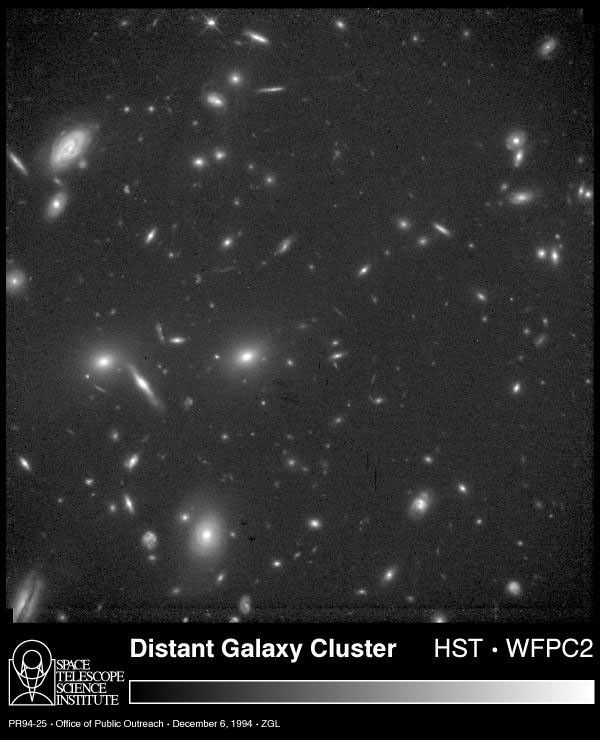1 min read
Galaxies in the Young Universe

[left] – This image of a small region of the constellation Sculptor, taken with a ground-based photographic sky survey camera, illustrates the extremely small angular size of a distant galaxy cluster in the night sky. Though this picture encompasses a piece of the sky about the width of the bowl of the Big Dipper, the cluster is so far away it fills a sky area only 1/10th the diameter of the Full Moon. The cluster members are not visible because they are so much fainter than foreground stars.
[center] – A NASA Hubble Space Telescope (HST) image of the farthest cluster of galaxies in the universe, located at a distance of 12 billion light-years. Because the light from these remote galaxies has taken 12 billion years to reach us, this image is a remarkable glimpse of the primeval universe, at it looked about two billion years after the Big Bang. The cluster contains 14 galaxies, the other objects are largely foreground galaxies. The galaxy cluster lies in front of quasar Q0000-263 in the constellation Sculptor. Presumably the brilliant core of an active galaxy, the quasar provides a beacon for searching for primordial galaxy clusters.
The image is the full field view of the Wide Field and Planetary Camera-2, taken on September 6, 1994. The 4.7-hour exposure reveals objects down to 28.5 magnitude.
[right] – This enlargement shows one of the farthest normal galaxies yet detected, (blob at center right) at a distance of 12 billion light-years (redshift of z=3.330). The galaxy lies 300 million light-years in front of the quasar Q0000-263 (z=4.11, large white blob and spike on left side of frame) and was detected because it absorbs some light from the quasar. The galaxy's spectrum reveals that vigorous star formation is taking place.
About the Object
- R.A. PositionR.A. PositionRight ascension – analogous to longitude – is one component of an object's position.00h 3m 22.9s
- Dec. PositionDec. PositionDeclination – analogous to latitude – is one component of an object's position.-26° 3' 16.8"
- Object NameObject NameA name or catalog number that astronomers use to identify an astronomical object.Q0000-263
- Release DateDecember 6, 1994
- Science ReleaseHubble Identifies Primeval Galaxies, Uncovers New Clues to the Universe’s Evolution
- Credit
Related Images & Videos

A Distant Cluster of Galaxies
[left] – One of the deepest images to date of the universe, taken with NASA's Hubble Space Telescope (HST), reveals thousands of faint galaxies at the detection limit of present day telescopes. Peering across a large volume of the observable cosmos, Hubble resolves thousands of...

Galaxies: Snapshots in Time
This sequence of NASA Hubble Space Telescope (HST) images of remote galaxies offers tantalizing initial clues to the evolution of galaxies in the universe. [far left column] These are traditional spiral and elliptical-shaped galaxies that make up the two basic classes of...

Remote Galaxy Clusters: Lost Ancestors to Our Milky Way Galaxy
This NASA Hubble Space Telescope (HST) image of the central portion of a remote cluster of galaxies (CL 0939+4713) as it looked when the universe was two-thirds of its present age. Hubble's high resolution allows astronomers to study, for the first time, the shapes of galaxies...
Share
Details
Claire Andreoli
NASA’s Goddard Space Flight Center
Greenbelt, Maryland
claire.andreoli@nasa.gov















































